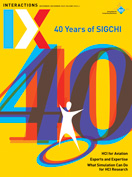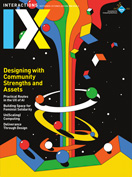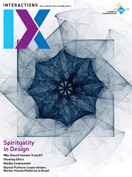Submissions
As the new Editors-in-Chief of Interactions, we—Mikael, Alex, and Daniela— would like invite you to be a part of shaping the next iteration of this exciting venue. What has brought us together as an editorial team is a common interest in design and technology, and in particular the importance of keeping the floor open to new and alternative voices and ways of doing design. Join us!
Recent Changes
We are deeply sensitive to the people who aren’t usually recognized in the annals of design and technology, and how versions of our work and the technologies we envision can inadvertently erase some pasts and presents, while amplifying and privileging others. These are the tensions and frictions that we will seek to make space for in the magazine, not foreclosing the debates but surfacing them to build the ground for new and different relationships with technology, that might just offer the conditions for more equitable and just futures. Part of this work will involve attracting a diversity of contributors and, if possible, broadening the readership to promote rich and critical perspectives on technology and UX design. We also plan to develop and extend the format of the magazine.
One of the biggest changes involves organizing content around particular debates or issues. Our hope is to put together a number of contributions (per issue) discussing a coherent theme, that engages readers, providing insight into the nuances that circulate technology and its design. To work toward a more inclusive and accessible format, we are setting our sights on multilingual translations, offering some content as open access (outside of the ACM Digital Library), and anchoring the magazine in values-based discussions. These ideas and others will take time to introduce, but we’re doing our best to make them a reality.
Submission Policy
General Submissions
We encourage everyone to submit to interactions magazine, independent of affiliation or discipline. To help us support a diversity of voices, we ask that you limit your submissions to three per year.
Special Issues and Guest Editing
Interactions does not publish traditional special issues, but each issue reflects a common theme. To support this content, guest editors curate thematic groupings (typically 2-4 Dialogue and Standpoint articles, between 2000-4000 words per piece). If you have an idea for a themed issue and would like to assemble a guest editing team and/or collection of material, we encourage you to reach out directly to the Editors-in-Chief at [email protected].
You are invited to submit to the content areas below. Except where otherwise specified, please use the following form to submit new content to Interactions: https://airtable.com/shr0sfqAldfNfkIs7?prefill_Status=Pending
Exhibit X: This highly visual section highlights four new works (artifacts, performances, exhibitions and other projects) that exemplify new and different forms of engagement. In addition to a short description of the project, authors must submit at least three high-quality images with captions. Word count: 100 words max.
Space: This image-heavy section offers readers an insider’s tour of studios, work sites, and research labs across the globe. Authors must submit at least 10 high-quality images documenting their space, capturing qualities of the physical environment and ways of working. Word count: 800 words max.
Making/Breaking: This section focuses on things people have built, broken, assembled, or disassembled. We are especially interested in the process behind these makings and breakings, how they have helped in developing and refining ongoing design work. Similar to Space, contributors must submit high-quality photos documenting the evolution of the project. Word count: 500 words max.
What Are You Reading? This section gives HCI practitioners and researchers the opportunity to share what they’ve been reading. Books, articles, magazines—it’s all good, though it is encouraged to select one or two items outside the HCI/interaction design genre. Authors can choose from writing one short essay describing what they’ve been reading or provide a list of three or four works, each followed by a short reflection. Word count: 500 words max.
Forum: Interactions has a select group of forums, each appearing in three issues per year. Forums have a specific focus but articles within any one forum can address a diverse range of viewpoints and research within that a particular sub-field. Contributors wishing to submit forum articles should contact the appropriate forum editor (see submissions form). Word count: 2200 words max.
Dialogues (New!): A dialogue is a new format for interactions. As editors, we’re hoping for dialogues to become the central focus of each issue, where a number of written pieces (and possibly other media formats) will discuss and debate a major theme in IX, HCI, design and beyond. Other regular content forms such as columns and forums may also respond to the theme.
The idea is that readers will gain more from engaging with a topic or theme that is spread across the content of an issue and subjected to a number of different, nuanced perspectives. We are thus looking to deepen the content in the magazine and add a more critical and discursive element.
With this in mind, we’re looking for groups of authors to propose or be part of developing a dialogue and to write two to three position pieces on the chosen topic/theme. Authors would also invite respondents to write responses to these position pieces. In all, a dialogue might include two to three feature length articles (2750 words) and an equal number of slightly shorter responses. We would also be excited to have proposals for very different formats and different media.
Features: (Update: the magazine will be publishing a reduced number of features from now on, shifting the emphasis to debates, outlined above). Feature articles can address relevant topics spanning the full breadth of human-computer interaction and interaction design, from accounts of hands-on work in design practice or field research, to summaries of new developments in design theory. Features tend to use an engaging, conversational writing style with minimal references and figures and build on existing published work by the authors (e.g., peer reviewed publications for research, awards, speaking invitations or similar recognition for creative and professional work). Features are not suitable as a first publication format for original research. Word count: 2750 words max.
Exit: The idea behind the gallery is to highlight and promote visual thinking, using the medium of still, possibly post-processed digital imagery in keeping with the role of interaction design as a design discipline. Word count: 100 words max.
Blogs: Blogs are intended for more informal personal reflections on current and topical issues in IxD and HCI. These are regularly posted online and are too juicy to wait for the bi-monthly magazine. Blogs are well suited for those burning issues you wouldn’t usually talk about in articles or research papers. We actively encourage early ideas, responses to conferences, workshops, symposia, papers, teaching and learning. You can ask questions, promote issues, discuss confusions, provoke curiosity or vent frustrations and more—anything that would benefit from a first-person perspective that speaks to readers more directly. Check out previous articles here: https://interactions.acm.org/blog. Word count: 1200 words max.
ALL ARTICLES SHOULD CONTAIN NO MORE THAN SIX ENDNOTES/REFERENCES.
Keep in mind the magazine and website represents the expertise and new discoveries within the HCI and interaction design research and practitioner communities. Our emphasis is on communicating our expertise and knowledge across our field and beyond. Submissions may be new material or based on material previously published in academic research venues but rewritten for a much broader audience.
Interactions is a magazine, not a scholarly journal. All efforts should be made to write in a professional magazine style, which means the tone should be as direct, inclusive, and conversational as possible. Special care should be taken to limit the use of jargon, academic phrases, formal constructions, and references. Although Interactions is created for those with a special interest in HCI, articles should be written so that any interested reader can understand and appreciate the material.
Editing and Review Processes
Articles go through several rounds of editing: first with the magazines editors-in-chief and forum editors for relevance, clarity, and groundedness and then with ACM’s managing editor and copy editor for grammar, punctuation, and length.
ACM staff will send authors the copyedited version for their review. Once they have approved the copyedited version, authors will not review the copy again.
Authors may be asked to review any redrawn figures.
Authors will not receive page proofs or final pdfs.
Images
We strongly encourage all authors to supply photos, illustrations, or illustrative concepts along with their manuscripts. All images must be supplied in-line so that placement near associated text is clear, and as separate files.
All images must be in JPEG or TIFF format and at least 300 DPI (and ideally at least 4800 pixels wide) with copyright clearance for use in the magazine. Please note that gaining copyright clearance for third-party material is the responsibility of the author(s); ACM will not seek clearance or cover cost that may be associated with clearance. For more information on procedures for securing third-party material, visit http://www.acm.org/publications/third-party-material
Interactions does not guarantee that all submitted images/illustrations will be published; such decisions are at the discretion of the editors-in-chief and ACM’s art department.
Submission Checklist
A complete submission to ACM Interactions should contain the following:
1. Word document (minimally formatted text and graphics) that includes a short, crisp working title or headline, and a standard byline: author name, affiliation, email address.
2. Separate graphics files in JPEG or TIFF format (at least 300 DPI/4800 px with copyright clearance).
3. Brief author biography (50-word maximum) for each author listed in the byline. A bio generally includes the author’s current affiliation and his/her research interests.
As a published ACM author, you and your co-authors are subject to all ACM Publications Policies, including ACM’s new Publications Policy on Research Involving Human Participants and Subjects.
Back to top
Demo Hour
-
March - April 2022
Seungwoo Je, Kongpyung Moon, Hyunseung Lim, Shan-Yuan Teng, Jas Brooks, Pedro Lopes, Andrea Bianchi
-
March - April 2022
Ian Gonsher, Zhenhong Lei
-
September - October 2020
Shengzhi Wu, Daragh Byrne, Molly Steenson, Robert Fraher, Laurel Fraher


